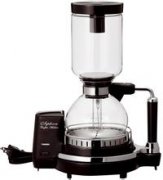Coffee beans and coffee beans

The varieties of coffee beans (Coffee Bean) can be divided into three types, namely
Arabica-Coffee contains about 1% per cent of caffeine by weight. Generally speaking, better quality and more expensive coffee beans come from coffee beans grown by Elaraby. It accounts for 3/4 of the world's output and is of good quality. because the coffee tree itself is very sensitive to heat and humidity, the growth conditions are at least 900m higher than the highland climate at sea level. the higher the height, the better the quality of the coffee beans. The caffeine content of this variety is low (1.1 ~ 1.7%). The color of coffee beans is green to light green, oval in shape and curved in grooves.
Robusta (Robusta)-Coffee contains about 2% of caffeine by weight. It accounts for about 20% and 30% of the world's output. It has strong resistance to tropical climate and is easy to cultivate. It grows very well at a sea level of 200 ─ 300m. However, its unique resistance also makes its concentration higher and its taste more bitter. Its caffeine content is high (20.4%). Coffee beans are round in shape, brown in color and with straight grooves.
Liberica-except for a few producing countries, only Europeans drink it. The aroma is poor, the bitter taste is strong, and the top of the coffee bean is diamond-shaped.
The variety of coffee
Variety
Arabica (plateau cultivation)
Robusta (lowland cultivation)
Liberica (minimum cultivation)
Production capacity
It accounts for 70% to 80% of the world's total output.
It accounts for 20% and 30% of the world's total output.
Except for the consumption of a small number of countries themselves, only people from mainland China can use it.
Planting ground point
Sloping ground with a height of 500m ~ 1000m
The height is below 500m.
Lowland or flat land below 200m
To buy a piece of paper
It should be high and low.
Resistant to high temperature
Resistant to high temperature and low temperature
Rain volume gauge
There should be more rain and less rain.
Withstand more rain and less rain
Withstand more rain and less rain
Yogao
5m / h 7m
5m
10m
Raw bean-shaped mackerel
The flat shape of the cymbal
The short shape of a cymbal.
The tip of the head is in the shape of a diamond.
Petal
5 lobes
6 valves
8 lobes
Fruit reality
The exocarp is hard, the endocarp is also solid, and the pericarp is easy to fall after maturity.
The pericarp is very thin between the exocarp and the endocarp, and more than a dozen conditions can be seen on the surface of the pericarp. After ripening, the pericarp is not easy to fall, and the pericarp is thin, so it is easy to separate from the seed.
As a matter of fact, the pericarp, endocarp and pericarp of Arabica are all very thick, especially the peel is glued to the peel, and the hard work of removing the peel is not easy to fall after maturity.
Cymbal tablet
The length of the 15cm film is in the shape of a cymbal, with a sharp point, and the surface of the sheet is dark and shiny.
The length of 10cm~20cm is slightly lower than that of Arabica, the meat is thinner than Liberica, the surface of noodles is bulging, and the whole noodles can be seen undulating like waves.
Taste channel
The smell is good.
There is a lack of fragrance, strong bitterness and insufficient sour taste.
The fragrance is not good, but the bitterness is strong.
Characteristic
The disease tolerance is poor, and there are several kinds of shelter in the places with low temperature of 15: 20.
The adaptability is strong, and the harvest quantity is the highest among the three original species.
Because of its strong disease tolerance and adaptability, it is often used as the original rootstock of Arabica.
Planting density
The highest is about 1.5 times of Robusta and 2 times of Liberica.
Tanzhong
Lowest
The main country of production
Brazil, Costa Rica, other Central and South American countries, Ethiopia, Angola, Mozambique, Tanzania, Angola, Kenya, Hawaii, Philippines, India, Indonesia, Papua New Guinea. Wait.
Visit all African countries, Hawaii, India, Indonesia, Trinidad and Tobago, the Philippines. Wait.
Liberia, Sri Lanka, Malaysia, India, Indonesia, Angola, Ivory Coast, Philippines.
Important Notice :
前街咖啡 FrontStreet Coffee has moved to new addredd:
FrontStreet Coffee Address: 315,Donghua East Road,GuangZhou
Tel:020 38364473
- Prev

Study on the Grinding coarseness of Coffee beans
Freshness is the first element of good coffee, and the second important task is to master the roughness and fineness of coffee beans, which directly affects the extraction effect, that is, the quality and intensity of coffee flavor. In principle, the finer the coffee powder, the longer the brewing time, the stronger the coffee flavor; on the other hand, the thicker the coffee powder, the shorter the brewing time, the lighter the taste. The longer the extraction time, the thicker the beans will be ground so as not to cause excessive extraction.
- Next

Knowledge related to freshness, packaging and storage of boutique coffee
Raw coffee beans (that is, unroasted beans) will not rot for several years. Once the raw beans enter the roasting process, the aroma wakes up and they begin to age day by day. Roasted coffee beans will lose their taste in three to four days if they are not properly preserved. If they are properly stored, the taste period may be extended by three or four months. Fresh coffee beans are easy to soak into mellow jade, and off-flavor coffee beans are hard to be immortals. Raw coffee beans are not good.
Related
- Beginners will see the "Coffee pull flower" guide!
- What is the difference between ice blog purified milk and ordinary milk coffee?
- Why is the Philippines the largest producer of crops in Liberia?
- For coffee extraction, should the fine powder be retained?
- How does extracted espresso fill pressed powder? How much strength does it take to press the powder?
- How to make jasmine cold extract coffee? Is the jasmine + latte good?
- Will this little toy really make the coffee taste better? How does Lily Drip affect coffee extraction?
- Will the action of slapping the filter cup also affect coffee extraction?
- What's the difference between powder-to-water ratio and powder-to-liquid ratio?
- What is the Ethiopian local species? What does it have to do with Heirloom native species?

